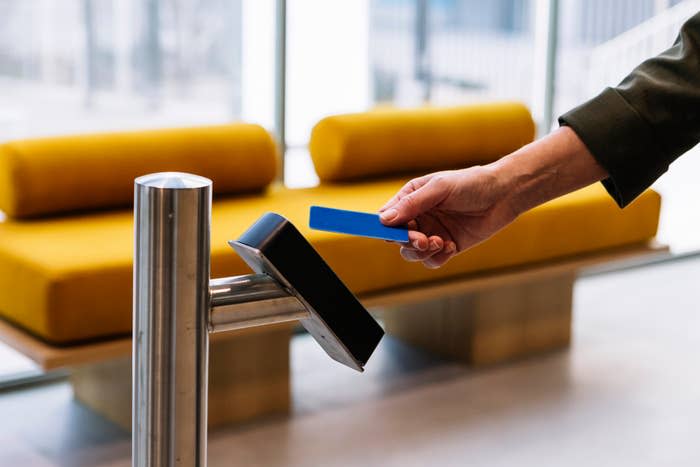Do you swipe in to your office building to meet your in-person mandate, but leave as soon as possible? There’s a word for your covert strategy: “coffee badging.”
It is where you show up to the office long enough for a coffee or a meeting expressly to fulfill in-office mandates — while primarily continuing to work from home whenever you can.
This new workplace lingo was popularized by videoconferencing company Owl Labs. The company defined it as “showing face at the office and then leaving.” In its 2023 report of 2,000 full-time U.S. workers, 58% of hybrid employees said they were “coffee badging,” with an additional 8% saying they were interested in trying it out.
And as hybrid arrangements have become a more permanent feature of office life, coffee badging is still here to stay. In a more recent June LinkedIn news poll of 1,568 people, 19% of LinkedIn users said they were still “coffee badging” into work.
Amanda, a Chicago-based IT project manager for a health insurance company, is one of them. Her company has a hybrid policy, and Amanda ― who asked to keep her last name private for her job ― said managers are open with employees that badge swipes are being tracked for “badge reports,” which calculate the percentage of people in office per week or month.


She has not had a conversation about her own attendance record, but knowing that her badge swipes could potentially result in a performance issue has made her diligent about commuting to the office because she does not “want to have that conversation come up at all.”
As a result, Amanda stays at least four hours to signal “I’m here,” she said, but will head home when she can. The feeling of having her attendance tracked does make her “uncomfortable.”
If she could, she would be a 100% remote employee, because she finds in-office days with commuting to be draining and “a waste of time” since her direct boss works in another city, and she has video meetings with remote colleagues.
“I don’t want to be here. I can do this from home,” Amanda said.
In this way, coffee badging in and out of work is a way to wrest back control and autonomy over how your job gets done. An employer may order some of my time, but not one second more than they must, is the strategic coffee badging philosophy.
Why coffee badging can also be a response to employer surveillance


And it’s not in employee’s heads ― badge logs can result in real negative consequences to one’s career. In January, one professional service firm reportedly showed some partners’ analysis that linked office attendance from turnstile data to mid-year performance ratings.
For her book, “The Algorithm: How AI Decides Who Gets Hired, Monitored, Promoted, and Fired and Why We Need to Fight Back Now,” journalist Hilke Schellmann interviewed a head of HR, who shared a story about a company making promotion and layoff decisions based on badge log data.
“They wanted to promote the people who had the longest hours at the office. So they looked at keycard swipe-in data,” Schellmann said about this company. “And then when it came to the pandemic, and they had to look at layoffs, they wanted to use this kind of data again to sort of understand who were the ‘least productive’ people, and they were going to look at the badge data logs.“
But to be clear, your badge swipes are a flawed signal of your performance at work.
Using badge swipes to determine productivity “could harm people who are on medical leave, or people who have caregiving obligations who we know have literally fewer chances to be at their desk than others,” Schellmann said.
So why are employers so tempted to find deeper meaning with badge logs despite the clear flaws? It might be because it is part of a growing field of people analytics.
“Companies want to use the data they have on their employees,” Schellmann said, noting that there is also a long-held mindset of “managers just sort of [wanting] to look around the room and see butts in seats.”
“It’s all about impression management,” she added.
But a word of caution to the coffee badger: You do need to stay longer than just a cup of coffee, because managers can easily look up how long you stayed at the office, and may feel betrayed by you popping in and out.
“Now with digital technology, everything leaves a trace, and that trace can be checked by superiors,” Schellmann said.
How to make coffee badging work for you


You can either go to the office begrudgingly or you can be pragmatic about the in-office mandate. The latter can be a helpful attitude adjustment.
“Try to reframe the coffee badging so that you feel that you’re making the most of this situation,” suggested Archana Bharathan, an executive coach at Columbia Business School.
Bharathan said she would go to her office less than her required three days a week if she had a choice, “but I would still go because I do see the benefit of it.“
Her role requires her to build and deepen relationships with colleagues, so she sees the face-time as a boost, but she acknowledges that if she were an individual contributor who mostly did Zoom calls, her productivity might decrease.
Bharathan’s advice to fellow coffee badgers is to find ways to make the time in office productive. She suggested scheduling meetings on in-person days.
“If you have the flexibility of choosing which three days you need to be in, figure out…how you can potentially combine your commute with other things that require attention in your personal life, [like] if you need to run errands,” she said.


And if you’re a manager of a team that is “coffee badging,” you should look deeper into why this trend is happening.
Ask yourself: “Are those who spend more time in the office delivering stronger results? Are they coming in for meetings and collaborative spaces? Or are they simply spending time commuting to sit on Zoom calls from the office instead of home?” suggested Bonnie Dilber, a recruiting manager with app-automation company Zapier.
“Great managers focus their teams on the highest impact actions, so my encouragement to any employer that sees employees going through the motions of meeting a minimum in-office expectation would be to consider whether the expectation is actually going to lead to impact,” she continued. “If the answer is yes, help your people recognize that so they’ll spend more time in the office, and if the answer is no, I’d revisit the requirement.”
Here’s a word to the wise: Coffee badging is not an accurate signal of someone’s performance. Busyness is not the same as accomplishment. Seeing a co-worker physically typing at their desk next to you does not mean they are actually working.
Take it from Amanda. Instead of putting weight into an employee’s number of badge swipes, she would want managers to instead “look at the work that’s actually being done and feedback from other people that [have] worked with the individual as a true measurement.”This article originally appeared on HuffPost.
